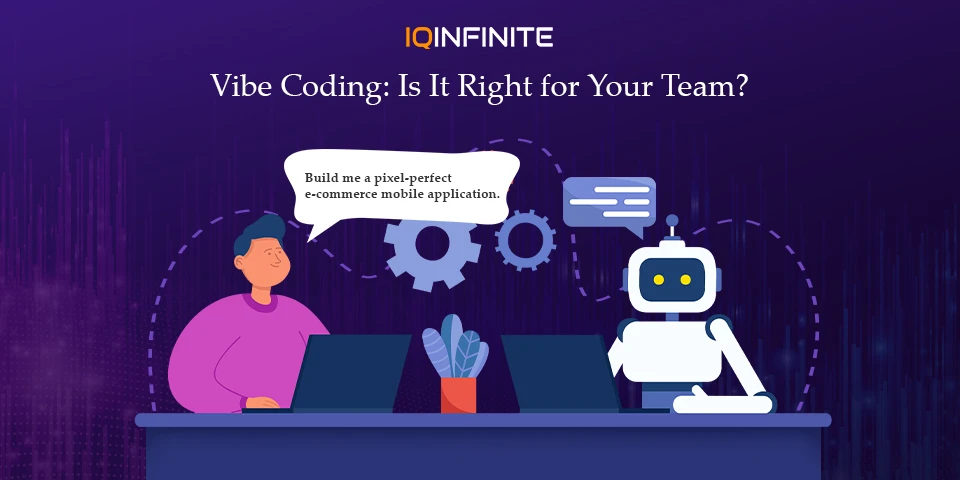Vibe Coding: What Is It & Should Your Team Adopt It?

Software development has always been a dance between structure and creativity. Over the years, teams have tried different collaborative approaches from pair programming to mob programming to spark innovation and maximize productivity. Now, a fresh style is making waves in the developer community: Vibe Coding.
But what exactly does “vibe coding” mean and could it be the missing piece that helps your team work smarter, faster and with more energy?
What is Vibe Coding?
Vibe Coding is a modern collaborative programming practice where developers work together in the same space either physical (like a shared office room) or virtual (via Zoom, Slack huddles or similar tools). Unlike pair programming (two people on one task) or mob programming (the whole team tackling a single piece of code), vibe coding is more flexible. Each developer focuses on their own ticket or task, but everyone stays connected in a shared environment.
The “vibe” comes from the atmosphere it creates:
The “vibe” comes from the atmosphere it creates:
- Side-by-side coding: Team members work in parallel, but within earshot (or a virtual channel) so communication is effortless.
- Organic knowledge sharing: Someone struggling with a bug can ask a quick question, while others can chime in with solutions or point to best practices.
- Collective momentum: Seeing teammates focused and productive helps everyone stay in flow, like co-working or study groups.
- Quick feedback loops: Instead of waiting for formal reviews or Slack replies, developers get near-instant input.
- Motivation & accountability: The presence of peers naturally keeps distractions in check and fosters team energy.
How Vibe Coding Differs from Other Methods
To understand vibe coding, it helps to compare it with other popular collaborative approaches:
1. Pair Programming: Two developers share a single task, often alternating between “driver” (writing code) and “navigator” (reviewing and guiding). It’s highly focused but can feel intense and limiting if used all the time.
2. Mob Programming: The entire team works on the same problem simultaneously, brainstorming, coding and reviewing as a unit. Great for complex challenges, but it demands high coordination and can slow down individual progress.
3. Vibe Coding: Developers work individually on related tasks but stay connected either in the same room or a virtual channel. This setup allows for spontaneous knowledge sharing, quick unblockers and a shared sense of momentum, without the rigidity of pair or mob programming.
In short, vibe coding blends autonomy with collaboration. Each person keeps ownership of their work while still tapping into the collective energy and expertise of the group.
1. Pair Programming: Two developers share a single task, often alternating between “driver” (writing code) and “navigator” (reviewing and guiding). It’s highly focused but can feel intense and limiting if used all the time.
2. Mob Programming: The entire team works on the same problem simultaneously, brainstorming, coding and reviewing as a unit. Great for complex challenges, but it demands high coordination and can slow down individual progress.
3. Vibe Coding: Developers work individually on related tasks but stay connected either in the same room or a virtual channel. This setup allows for spontaneous knowledge sharing, quick unblockers and a shared sense of momentum, without the rigidity of pair or mob programming.
In short, vibe coding blends autonomy with collaboration. Each person keeps ownership of their work while still tapping into the collective energy and expertise of the group.
Benefits of Vibe Coding
- Seamless Knowledge Sharing: Encourages organic learning as junior and senior developers exchange ideas and techniques.
- Higher Productivity: Roadblocks get resolved faster, keeping projects moving smoothly.
- Stronger Team Connection: Builds camaraderie and trust, especially valuable in remote or hybrid setups.
- Sharper Focus: Collective work sessions minimize context-switching and reduce distractions, helping everyone stay in flow.
Should Your Team Adopt Vibe Coding?
Vibe Coding isn’t a one-size-fits-all solution it shines in teams that value collaboration, rapid feedback and open communication. It can be especially effective for:
• Distributed or hybrid teams that want to stay connected and maintain a sense of presence.
• Startups and small teams where agility and fast iteration are key.
• Learning-focused groups perfect for onboarding juniors or experimenting with new technologies.
If your team enjoys autonomy but sometimes feels isolated, vibe coding can bridge the gap between independent work and structured collaboration, creating a natural flow of energy, knowledge sharing and motivation.
• Distributed or hybrid teams that want to stay connected and maintain a sense of presence.
• Startups and small teams where agility and fast iteration are key.
• Learning-focused groups perfect for onboarding juniors or experimenting with new technologies.
If your team enjoys autonomy but sometimes feels isolated, vibe coding can bridge the gap between independent work and structured collaboration, creating a natural flow of energy, knowledge sharing and motivation.
Conclusion
At its core, vibe coding isn’t about rigid rules it’s about crafting an environment where coding feels collective and energizing. Teams that prioritize shared momentum, reduced friction and stronger bonds often see the biggest payoff.
Start small: try a few vibe coding sessions, gather feedback and see if the energy clicks. If it does, you might just unlock a new level of productivity and team cohesion.
Start small: try a few vibe coding sessions, gather feedback and see if the energy clicks. If it does, you might just unlock a new level of productivity and team cohesion.
